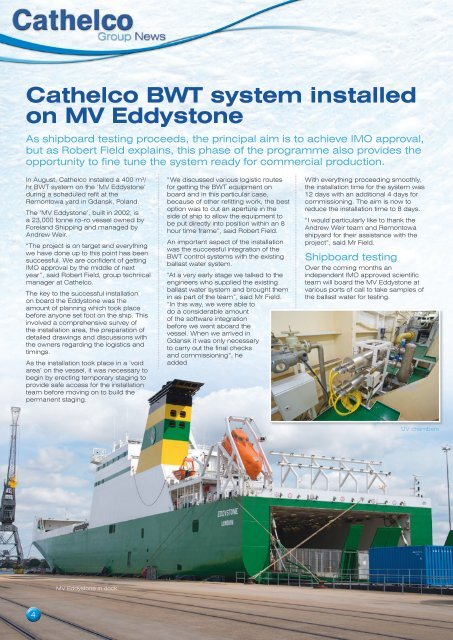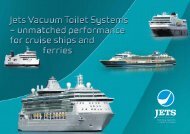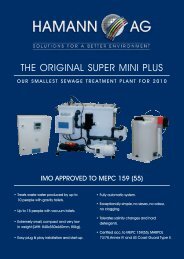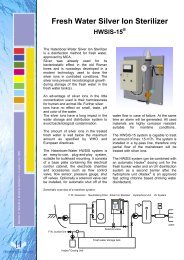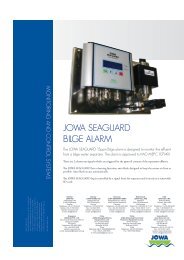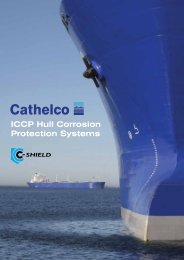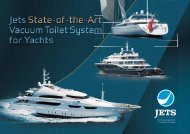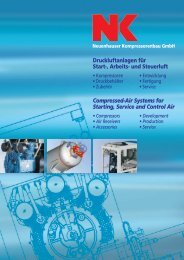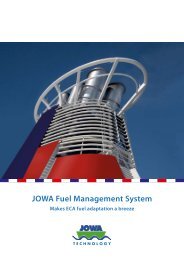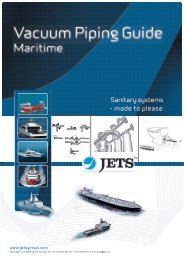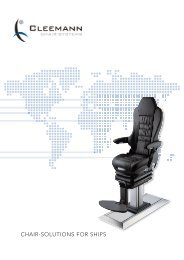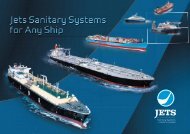Download the newsletter here - Marine Plant Systems
Download the newsletter here - Marine Plant Systems
Download the newsletter here - Marine Plant Systems
Create successful ePaper yourself
Turn your PDF publications into a flip-book with our unique Google optimized e-Paper software.
Ca<strong>the</strong>lco BWT system installedon MV EddystoneAs shipboard testing proceeds, <strong>the</strong> principal aim is to achieve IMO approval,but as Robert Field explains, this phase of <strong>the</strong> programme also provides <strong>the</strong>opportunity to fine tune <strong>the</strong> system ready for commercial production.In August, Ca<strong>the</strong>lco installed a 400 m 3 /hr BWT system on <strong>the</strong> ‘MV Eddystone’during a scheduled refit at <strong>the</strong>Remontowa yard in Gdansk, Poland.The ‘MV Eddystone’, built in 2002, isa 23,000 tonne ro-ro vessel owned byForeland Shipping and managed byAndrew Weir.“The project is on target and everythingwe have done up to this point has beensuccessful. We are confident of gettingIMO approval by <strong>the</strong> middle of nextyear”, said Robert Field, group technicalmanager at Ca<strong>the</strong>lco.The key to <strong>the</strong> successful installationon board <strong>the</strong> Eddystone was <strong>the</strong>amount of planning which took placebefore anyone set foot on <strong>the</strong> ship. Thisinvolved a comprehensive survey of<strong>the</strong> installation area, <strong>the</strong> preparation ofdetailed drawings and discussions with<strong>the</strong> owners regarding <strong>the</strong> logistics andtimings.As <strong>the</strong> installation took place in a ‘voidarea’ on <strong>the</strong> vessel, it was necessary tobegin by erecting temporary staging toprovide safe access for <strong>the</strong> installationteam before moving on to build <strong>the</strong>permanent staging.“We discussed various logistic routesfor getting <strong>the</strong> BWT equipment onboard and in this particular case,because of o<strong>the</strong>r refitting work, <strong>the</strong> bestoption was to cut an aperture in <strong>the</strong>side of ship to allow <strong>the</strong> equipment tobe put directly into position within an 8hour time frame”, said Robert Field.An important aspect of <strong>the</strong> installationwas <strong>the</strong> successful integration of <strong>the</strong>BWT control systems with <strong>the</strong> existingballast water system.“At a very early stage we talked to <strong>the</strong>engineers who supplied <strong>the</strong> existingballast water system and brought <strong>the</strong>min as part of <strong>the</strong> team”, said Mr Field.“In this way, we were able todo a considerable amountof <strong>the</strong> software integrationbefore we went aboard <strong>the</strong>vessel. When we arrived inGdansk it was only necessaryto carry out <strong>the</strong> final checksand commissioning”, headdedWith everything proceeding smoothly,<strong>the</strong> installation time for <strong>the</strong> system was12 days with an additional 4 days forcommissioning. The aim is now toreduce <strong>the</strong> installation time to 8 days.“I would particularly like to thank <strong>the</strong>Andrew Weir team and Remontowashipyard for <strong>the</strong>ir assistance with <strong>the</strong>project”, said Mr Field.Shipboard testingOver <strong>the</strong> coming months anindependent IMO approved scientificteam will board <strong>the</strong> MV Eddystone atvarious ports of call to take samples of<strong>the</strong> ballast water for testing.UV chambersMV Eddystone in dock4


